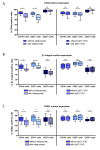The anti-CD74 humanized monoclonal antibody, milatuzumab, which targets the invariant chain of MHC II complexes, alters B-cell proliferation, migration, and adhesion molecule expression
- PMID: 22404985
- PMCID: PMC3446420
- DOI: 10.1186/ar3767
The anti-CD74 humanized monoclonal antibody, milatuzumab, which targets the invariant chain of MHC II complexes, alters B-cell proliferation, migration, and adhesion molecule expression
Abstract
Introduction: Targeting CD74 as the invariant chain of major histocompatibility complexes (MHC) became possible by the availability of a specific humanized monoclonal antibody, milatuzumab, which is under investigation in patients with hematological neoplasms. CD74 has been reported to regulate chemo-attractant migration of macrophages and dendritic cells, while the role of CD74 on peripheral naïve and memory B cells also expressing CD74 remains unknown. Therefore, the current study addressed the influence of milatuzumab on B-cell proliferation, chemo-attractant migration, and adhesion molecule expression.
Methods: Surface expression of CD74 on CD27- naïve and CD27+ memory B cells as well as other peripheral blood mononuclear cells (PBMCs) obtained from normals, including the co-expression of CD44, CXCR4, and the adhesion molecules CD62L, β7-integrin, β1-integrin and CD9 were studied after binding of milatuzumab using multicolor flow cytometry. The influence of the antibody on B-cell proliferation and migration was analyzed in vitro in detail.
Results: In addition to monocytes, milatuzumab also specifically bound to human peripheral B cells, with a higher intensity on CD27+ memory versus CD27- naïve B cells. The antibody reduced B-cell proliferation significantly but moderately, induced enhanced spontaneous and CXCL12-dependent migration together with changes in the expression of adhesion molecules, CD44, β7-integrin and CD62L, mainly of CD27- naïve B cells. This was independent of macrophage migration-inhibitory factor as a ligand of CD74/CD44 complexes.
Conclusions: Milatuzumab leads to modestly reduced proliferation, alterations in migration, and adhesion molecule expression preferentially of CD27- naïve B cells. It thus may be a candidate antibody for the autoimmune disease therapy by modifying B cell functions.
Figures




Similar articles
-
Epratuzumab targeting of CD22 affects adhesion molecule expression and migration of B-cells in systemic lupus erythematosus.Arthritis Res Ther. 2010;12(6):R204. doi: 10.1186/ar3179. Epub 2010 Nov 4. Arthritis Res Ther. 2010. PMID: 21050432 Free PMC article.
-
Milatuzumab-SN-38 conjugates for the treatment of CD74+ cancers.Mol Cancer Ther. 2013 Jun;12(6):968-78. doi: 10.1158/1535-7163.MCT-12-1170. Epub 2013 Feb 20. Mol Cancer Ther. 2013. PMID: 23427296
-
Combination anti-CD74 (milatuzumab) and anti-CD20 (rituximab) monoclonal antibody therapy has in vitro and in vivo activity in mantle cell lymphoma.Blood. 2011 Apr 28;117(17):4530-41. doi: 10.1182/blood-2010-08-303354. Epub 2011 Jan 12. Blood. 2011. PMID: 21228331 Free PMC article.
-
Milatuzumab: a promising new agent for the treatment of lymphoid malignancies.Expert Opin Investig Drugs. 2009 Jan;18(1):99-104. doi: 10.1517/13543780802636162. Expert Opin Investig Drugs. 2009. PMID: 19053886 Review.
-
The secret second life of an innocent chaperone: the story of CD74 and B cell/chronic lymphocytic leukemia cell survival.Leuk Lymphoma. 2011 Aug;52(8):1446-54. doi: 10.3109/10428194.2011.565437. Epub 2011 Mar 21. Leuk Lymphoma. 2011. PMID: 21417823 Review.
Cited by
-
Development of combinatorial antibody therapies for diffuse large B cell lymphoma.Front Med (Lausanne). 2022 Oct 24;9:1034594. doi: 10.3389/fmed.2022.1034594. eCollection 2022. Front Med (Lausanne). 2022. PMID: 36353222 Free PMC article.
-
The role of CD74 in cardiovascular disease.Front Cardiovasc Med. 2023 Jan 12;9:1049143. doi: 10.3389/fcvm.2022.1049143. eCollection 2022. Front Cardiovasc Med. 2023. PMID: 36712241 Free PMC article. Review.
-
Slow-replicating leukemia cells represent a leukemia stem cell population with high cell-surface CD74 expression.Mol Oncol. 2024 Oct;18(10):2554-2568. doi: 10.1002/1878-0261.13690. Epub 2024 Jun 22. Mol Oncol. 2024. PMID: 38922758 Free PMC article.
-
Target Therapy in Hematological Malignances: New Monoclonal Antibodies.Int Sch Res Notices. 2014 Oct 29;2014:701493. doi: 10.1155/2014/701493. eCollection 2014. Int Sch Res Notices. 2014. PMID: 27433507 Free PMC article. Review.
-
High CD74 expression correlates with ZAP70 expression in B cell chronic lymphocytic leukemia patients.Med Oncol. 2013;30(2):560. doi: 10.1007/s12032-013-0560-5. Epub 2013 Apr 10. Med Oncol. 2013. PMID: 23572149 Free PMC article.
References
-
- Binsky I, Haran M, Starlets D, Gore Y, Lantner F, Harpaz N, Leng L, Goldenberg DM, Shvidel L, Berrebi A, Bucala R, Shachar I. IL-8 secreted in a macrophage migration-inhibitory factor- and CD74-dependent manner regulates B cell chronic lymphocytic leukemia survival. Proc Natl Acad Sci USA. 2007;104:13408–13413. doi: 10.1073/pnas.0701553104. - DOI - PMC - PubMed
-
- Lamb CA, Cresswell P. Assembly and transport properties of invariant chain trimers and HLA-DR-invariant chain complexes. J Immunol. 1992;148:3478–3482. - PubMed
Publication types
MeSH terms
Substances
LinkOut - more resources
Full Text Sources
Other Literature Sources
Medical
Research Materials
Miscellaneous

